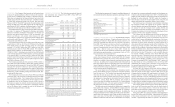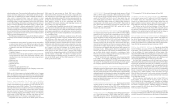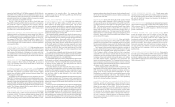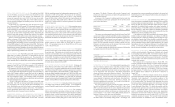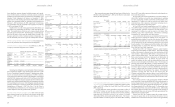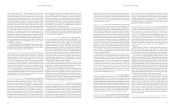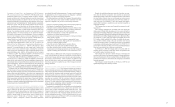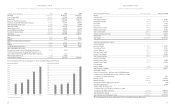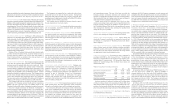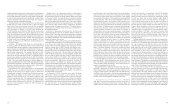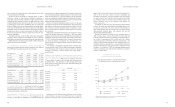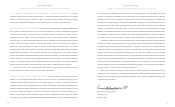Abercrombie & Fitch 2006 Annual Report Download - page 17
Download and view the complete annual report
Please find page 17 of the 2006 Abercrombie & Fitch annual report below. You can navigate through the pages in the report by either clicking on the pages listed below, or by using the keyword search tool below to find specific information within the annual report.
Abercrombie &Fitch
33
and comprehensive income. The term of the lease over which the
Company amortizes construction allowances and minimum rental
expenses on a straight-line basis begins on the date of initial possession,
which is generally when the Company enters the space and begins to
make improvements in preparation for intended use.
Certain leases provide for contingent rents, which are deter-
mined as a percentage of gross sales in excess of specified levels. The
Company records a contingent rent liability in accrued expenses on
the Consolidated Balance Sheet and the corresponding rent expense
when management determines that achieving the specified levels
during the fiscal year is probable.
STORE PRE-OPENING EXPENSES Pre-opening expenses relat-
ed to new store openings are charged to operations as incurred.
DESIGN AND DEVELOPMENT COSTS Costs to design and
develop the Company’s merchandise are expensed as incurred and
are reflected as a component of “Marketing, General and Admin-
istrative Expense.”
FAIR VALUE OF FINANCIAL INSTRUMENTS The recorded
values of current assets and current liabilities, including receivables,
marketable securities, other assets and accounts payable, approximate
fair value due to the short maturity and because the average interest
rate approximates current market origination rates.
EARNINGS PER SHARE Net income per share is computed in
accordance with SFAS No. 128, “Earnings Per Share.” Net income per
basic share is computed based on the weighted-average number of out-
standing shares of common stock. Net income per diluted share
includes the weighted-average effect of dilutive stock options and
restricted stock units.
Weighted–Average Shares Outstanding (in thousands):
2006 2005 2004
Shares of Class A Common Stock issued 103,300 103,300 103,300
Treasury shares outstanding (15,248) (16,139) (10,523)
Basic shares outstanding 88,052 87,161 92,777
Dilutive effect of options and
restricted stock units 3,958 4,060 2,333
Diluted shares outstanding 92,010 91,221 95,110
Options to purchase 0.1 million, 0.2 million and 5.2 million shares
of Class A Common Stock were outstanding for Fiscal 2006, Fiscal
2005 and Fiscal 2004, respectively, but were not included in the com-
putation of net income per diluted share because the options’ exercise
prices were greater than the average market price of the underlying shares.
SHARE-BASED COMPENSATION See Note 4 of the Notes to
Consolidated Financial Statements.
USE OF ESTIMATES IN THE PREPARATION OF FINAN-
CIAL STATEMENTS
The preparation of financial statements in
conformity with GAAP requires management to make estimates and
assumptions that affect the reported amounts of assets and liabilities as
of the date of the financial statements and the reported amounts of rev-
enues and expenses during the reporting period. Since actual results
may differ from those estimates, the Company revises its estimates and
assumptions as new information becomes available.
3. RECENTLY ISSUED ACCOUNTING PRONOUNCEMENTS
In July 2006, the FASB released Interpretation No. 48, “Accounting for
Uncertainty in Income Taxes – an Interpretation of FASB Statement 109,
Accounting for Income Taxes” (“FIN 48”). FIN 48 provides a comprehen-
sive model for how a company should recognize, measure, present and
disclose in its financial statements uncertain tax positions that the com-
pany has taken or expects to take on a tax return. FIN 48 defines the
threshold for recognizing tax return positions in the financial statements
as “more likely than not” that the position is sustainable, based on its mer-
its. FIN 48 also provides guidance on the measurement, classification
and disclosure of tax return positions in the financial statements. FIN 48
is effective for the first reporting period beginning after December 15,
2006, with the cumulative effect of the change in accounting principle
recorded as an adjustment to the beginning balance of retained earnings
in the period of adoption. An analysis of the impact of this interpretation
is not yet complete; however, the Company expects to record an adjust-
ment to reduce opening retained earnings in the first quarter of Fiscal
2007 by an amount which is not material to its financial statements.
In September 2006, the Securities and Exchange Commission issued
Staff Accounting Bulletin (“SAB”) No. 108, “Considering the Effects
of Prior Year Misstatements when Quantifying Misstatements in Current
Year Financial Statements.” SAB No. 108 requires a “dual approach” for
quantifications of errors using both a method that focuses on the
income statement impact, including the cumulative effect of prior years’
misstatements, and a method that focuses on the period-end balance
sheet. SAB No. 108 was effective for the Company for Fiscal 2006. The
adoption of SAB No. 108 did not have any impact on the Company’s
consolidated financial statements.
In September 2006, the FASB released FASB Statement No. 157,
“Fair Value Measurements” (“SFAS 157”). SFAS 157 establishes a
common definition for fair value under GAAP, establishes a frame-
work for measuring fair value and expands disclosure requirements
about such fair value measurements. SFAS 157 will be effective for
the Company on February 3, 2008. The Company is currently eval-
uating the potential impact on the consolidated financial statements
of adopting SFAS 157.
In February 2007, the FASB released FASB Statement No. 159,
“The Fair Value Option for Financial Assets and Financial Liabilities”
(“SFAS 159”). SFAS 159 permits companies to measure many financial
instruments and certain other assets and liabilities at fair value on an
instrument by instrument basis. SFAS 159 also establishes presentation
and disclosure requirements to facilitate comparisons between compa-
nies that select different measurement attributes for similar types of
assets and liabilities. SFAS 159 will be effective for the Company on
February 3, 2008. The Company is currently evaluating the potential
impact on the consolidated financial statements of adopting SFAS 159.
Abercrombie &Fitch
32
actions are included in the results of operations, whereas related translation
adjustments are reported as an element of other comprehensive income
in accordance with SFAS No. 130, “Reporting Comprehensive Income.”
CONTINGENCIES In the normal course of business, the Company
must make continuing estimates of potential future legal obligations and
liabilities, which require management’s judgment on the outcome of var-
ious issues. Management may also use outside legal advice to assist in the
estimating process. However, the ultimate outcome of various legal issues
could be different than management estimates, and adjustments may be
required. The Company accrues for its legal obligations for outstanding
bills, expected defense costs and, if appropriate, settlements. Accruals are
made for personnel, general litigation and intellectual property cases.
SHAREHOLDERS’ EQUITY At February 3, 2007 and January 28,
2006, there were 150 million shares of $0.01 par value Class A Common
Stock authorized, of which 88.3 million and 87.7 million shares were
outstanding at February 3, 2007 and January 28, 2006, respectively, and
106.4 million shares of $0.01 par value Class B Common Stock author-
ized, none of which were outstanding at February 3, 2007 or January 28,
2006. In addition, 15 million shares of $0.01 par value Preferred Stock
were authorized, none of which have been issued. See Note 15 of the
Notes to Consolidated Financial Statements for information about
Preferred Stock Purchase Rights.
Holders of Class A Common Stock generally have identical rights
to holders of Class B Common Stock, except that holders of Class A
Common Stock are entitled to one vote per share while holders of
Class B Common Stock are entitled to three votes per share on all
matters submitted to a vote of shareholders.
REVENUE RECOGNITION The Company recognizes retail sales
at the time the customer takes possession of the merchandise and
purchases are paid for, primarily with either cash or credit card. Direct-
to-consumer sales are recorded upon customer receipt of merchandise.
Amounts relating to shipping and handling billed to customers in a sale
transaction are classified as revenue and the related direct shipping and
handling costs are classified as stores and distribution expense. Associate
discounts are classified as a reduction of revenue. The Company reserves
for sales returns through estimates based on historical experience and
various other assumptions that management believes to be reasonable.
The sales return reserve was $8.9 million, $8.2 million and $6.7 million at
February 3, 2007, January 28, 2006 and January 29, 2005, respectively.
The Company’s gift cards do not expire or lose value over periods
of inactivity. The Company accounts for gift cards by recognizing a
liability at the time a gift card is sold. The liability remains on the
Company’s books until the earlier of redemption (recognized as revenue)
or when the Company determines the likelihood of redemption is
remote (recognized as other operating income). The Company deter-
mines the probability of the gift card being redeemed to be remote based
on historical redemption patterns and at these times recognizes the
remaining balance as other operating income. At February 3, 2007 and
January 28, 2006, the gift card liability on the Company’s Consolidated
Balance Sheet was $65.0 million and $53.2 million, respectively.
The Company is not required by law to escheat the value of unre-
deemed gift cards to the states in which it operates. During Fiscal
2006, Fiscal 2005 and Fiscal 2004, the Company recognized other
operating income for adjustments to the gift card liability of $5.2 million,
$2.4 million and $4.3 million, respectively.
The Company does not include tax amounts collected as part of
the sales transaction in its net sales results.
COST OF GOODS SOLD Cost of goods sold includes among others,
cost of merchandise, markdowns, inventory shrink and valuation
reserves and freight expenses.
STORES AND DISTRIBUTION EXPENSE Stores and distribu-
tion expense includes store payroll, store management, rent, utilities
and other landlord expenses, depreciation and amortization, repairs
and maintenance and other store support functions and direct-to-con-
sumer and DC expenses.
MARKETING, GENERAL & ADMINISTRATIVE EXPENSE
Marketing, general and administrative expense includes photography
and media ads, store marketing, home office payroll, except for those
departments included in stores and distribution expense, information
technology, outside services such as legal and consulting, relocation and
employment and travel expenses.
OTHER OPERATING INCOME, NET Other operating income
consists primarily of gift card balances whose likelihood of redemp-
tion has been determined to be remote and are therefore recognized
as income. Other operating income in Fiscal 2006 also included non-
recurring benefits from insurance reimbursements received for fire
and Hurricane Katrina damage.
CATALOGUE AND ADVERTISING COSTS Catalogue costs
consist primarily of catalogue production and mailing costs and are
expensed as incurred as a component of “Stores and Distribution
Expense.” Advertising costs consist of in-store photographs and
advertising in selected national publications and billboards and are
expensed as part of “Marketing, General and Administrative
Expense” when the photographs or publications first appear.
Catalogue and advertising costs, which include photo shoot costs,
amounted to $39.3 million in Fiscal 2006, $36.8 million in Fiscal 2005
and $33.8 million in Fiscal 2004.
OPERATING LEASES The Company leases property for its stores
under operating leases. Most lease agreements contain construction
allowances, rent escalation clauses and/or contingent rent provisions.
For construction allowances, the Company records a deferred lease
credit on the consolidated balance sheet and amortizes the deferred
lease credit as a reduction of rent expense on the consolidated statement
of net income and comprehensive income over the terms of the leases.
For scheduled rent escalation clauses during the lease terms, the
Company records minimum rental expenses on a straight-line basis
over the terms of the leases on the consolidated statement of net income


